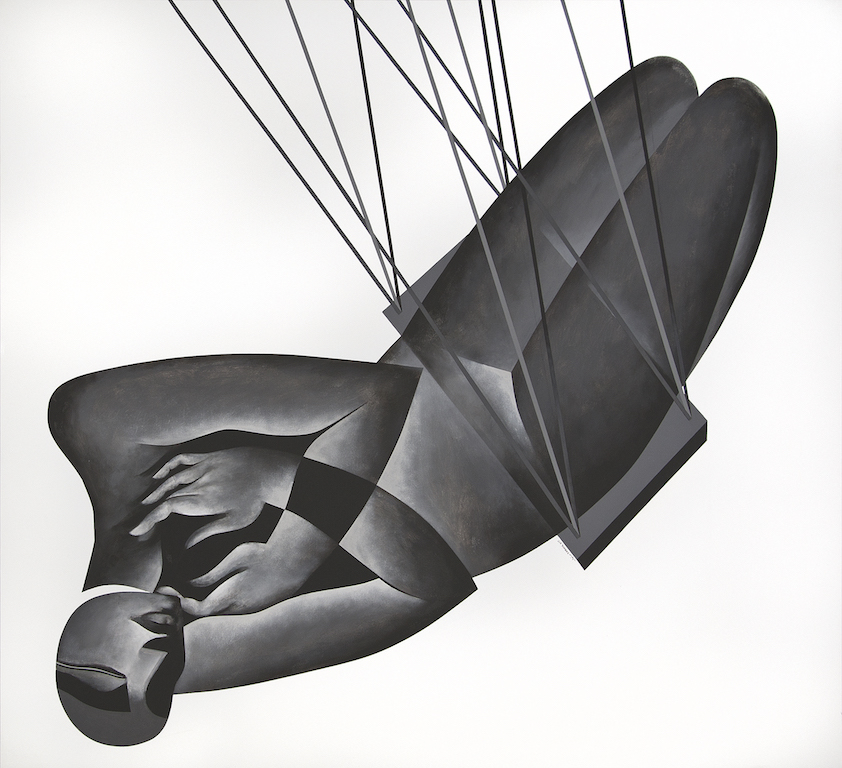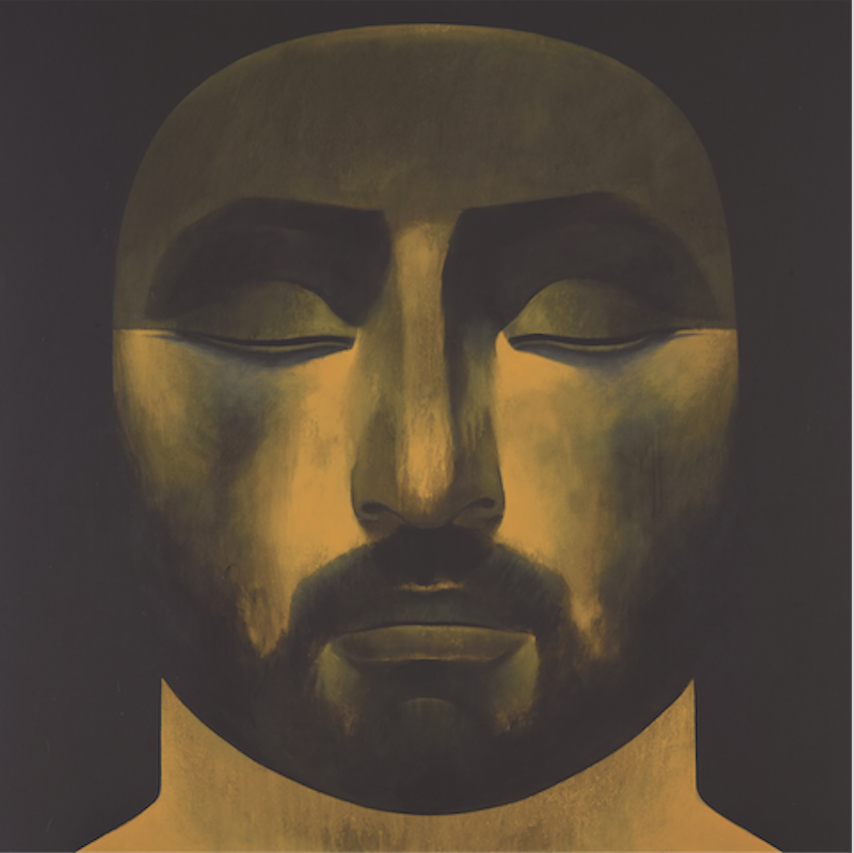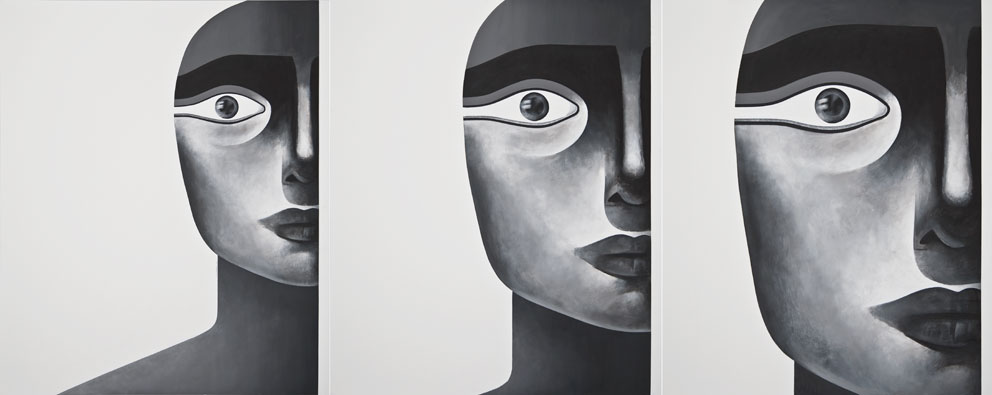Safwan Dahoul’s recent paintings indicate several new developments in his ongoing Dream series, the influential body of work that has distinguished his career. Although the psychologically laden paintings are widely exhibited and collected, little is known about the origins of the series other than the fact that it began as an autobiographical reflection of time but has since grown to represent the mounting devastation and desolation of the Syrian crisis.
While I have written extensively on Dahoul’s work, I am still left with many questions. With each reading of the series, I continue to discover things, layers that I missed when focusing on other aspects of his recurring subject matter and shifting forms. Essentially, the paintings allow for infinite interpretations but the underlying meaning remains the same. This degree of inventiveness, with which a single artwork gradually reveals information but continues to mystify viewers, can only be attributed to the mastery of an artist who is well-versed in the language of his medium yet insists on defying its basic principles.
Dahoul began his career in Syria while studying with leading modernists such as Mahmoud Hammad and Elias Zayat at the University of Damascus’ Faculty of Fine Arts. Like a number of pioneering figures, Hammad and Zayat deconstructed the aesthetic legacy of Syrian visual culture by examining the formalism of traditional imagery such as Arabic calligraphy and ancient iconography. Similarly, as the Dream series progressed, Dahoul began to appropriate historical forms without the burden of their original significations, giving new meaning to familiar signs.
During Dahoul’s second year at the Faculty of Fine Arts, Zayat noticed parallels between his compositions and the seminal works of figurative painter Louay Kayyali. Unfamiliar with his paintings, Dahoul sought out examples and quickly developed an affinity for the complexity of Kayyali’s protagonists.
Although not his university instructor, towering painter Fateh Moudarres also took an interest in Dahoul’s early work and insisted on writing the introduction to his first exhibition, which was held at Gallery El Sayed in Damascus in 1989. Among the artists of the older generation, Moudarres was arguably the greatest mentor, offering encouragement to young and emerging painters—a role that Dahoul inadvertently filled when he resettled in Syria after completing a PhD in Belgium and taught at the Faculty of Fine Arts.
In many ways, Dahoul’s presence in the Damascus art scene, and later among regional painters, can be understood as a continuation of the deep sense of engagement and commitment that defined the modernist era and was advocated by his predecessors. Dahoul has succeeded in taking their aesthetic experiments into uncharted territory while also reimagining how figurative painting can serve as a window into the psychosocial dimensions of our rapidly changing world.
In the following interview, Dahoul describes the fundamental aspects of his Dream paintings, revealing how over a thirty-year period, he has remained inspired by the original aim of the series.
 [Safwan Dahoul, Dream 116 (2015). Image copyright the artist. Courtesy of Ayyam Gallery.]
[Safwan Dahoul, Dream 116 (2015). Image copyright the artist. Courtesy of Ayyam Gallery.]
Maymanah Farhat (MF): You began your Dream series in the 1980s and although the subject matter is the same, there have been significant changes in the forms that describe your figures and their surrounding environments. What characteristics define the series for you?
Safwan Dahoul (SD): Changes are undoubtedly triggered by what we are surrounded with whether it be love or joy, death or war. All of these things must be reflected in my works. When we speak about thirty years of work, we have countless changes, while the main characteristic is in line with what occurs around us in all of its details.
MF: What was the initial inspiration for the series? How did it come about?
SD: Most of the time the idea corresponds with a unique personal event and a sign that we at times intercept and at other times miss, maybe it’s fate and I believe in that.
 [Safwan Dahoul, Dream 117 (2016). Image copyright the artist. Courtesy of Ayyam Gallery.]
[Safwan Dahoul, Dream 117 (2016). Image copyright the artist. Courtesy of Ayyam Gallery.]
MF: When you began the series, was it a conscious decision to work on the same subject matter for an extended period of time? Was that a central concept to begin with, or did that develop as you delved further into the work?
SD: It was never my intention to stay alive until now, and I haven’t made the conscious decision that I would be painting what I am painting now, I only know that I have finished my most recent work and I am awaiting a blank canvas before me to fill anew. I follow my instinct, that’s all.
 [Safwan Dahoul, Dream 112 (2015). Image copyright the artist. Courtesy of Ayyam Gallery.]
[Safwan Dahoul, Dream 112 (2015). Image copyright the artist. Courtesy of Ayyam Gallery.]
MF: Repetition is an important component of the Dream paintings, not only in the image of your female protagonist but also in the spaces she appears and the objects that accompany her. Changes gradually occur over time, with slight differences from one painting to the next. How does this repetition of visuals function in the ongoing narrative of the series?
SD: What runs through my veins since I was born is my blood, and on the white canvas before me, my painting, all that has changed is a result of time. Similarly, the visual repetitions that occurred on my face, my body, and my soul are the same repetitions that occur in my painting.
 [Safwan Dahoul, Dream (2008). Image copyright the artist. Courtesy of Ayyam Gallery.]
[Safwan Dahoul, Dream (2008). Image copyright the artist. Courtesy of Ayyam Gallery.]
MF: In each composition the story of the protagonist is alluded to through details such as the position of her body, yet looking at the span of the series and how the figure struggles to adapt to confined space, or appears to search for shelter, heightens the sense of alienation, solitude, or crisis that is communicated throughout. Is it your intention for the viewer to understand each painting as part of the larger body of work or do you feel that an individual composition encapsulates these unified themes?
SD: It is true that this is a series concerned with one topic that is composed of few elements, however I certainly believe that every piece is independent and yet it belongs to its own world. It has to belong to the specific date that the work carries with the changes that accompany it, and it certainly has to belong to the series as a part of this experience.
MF: When viewing the series as a whole, it becomes clear that a noticeable change in palette has occurred at different times. For example, in the early 2000s your paintings became darker and concentrated in black, gray, and white. How does color function in your work? What leads you to abandon a specific color scheme and begin anew?
SD: This is despite not being classified as a colorist, meaning I don`t use yellow, red, blue, etc. So, just like the elements in my works are few, so are the colors. As I said before, my intuition guides me towards what I need. What currently interests me is the color white, many believe it to be the color of life, many also think it`s the color of death. In the concept of art, white is both a non-color and the sum of all colors simultaneously. This contradiction pulls me towards this mysterious color, which is what I currently need.
 [Safwan Dahoul, Dream 96 (2015). Image copyright the artist. Courtesy of Ayyam Gallery.]
[Safwan Dahoul, Dream 96 (2015). Image copyright the artist. Courtesy of Ayyam Gallery.]
MF: Objectively speaking, dreams consist of a sequence of images drawn from the familiar that then trigger sensations. Some cultures have attempted to dissect and interpret dreams for hidden meaning or insight into the past, present, and future. How might we come to understand the title of the series? Is it a vision that haunts you, like a recurring dream? Or does the title reference the ongoing sense of restlessness of your figure, as though she is caught in a moment of disquiet, seeking comfort in slumber or rest?
SD: Indeed, the "dream" in my works is everything that you mentioned, and there`s a difference between dreams, visions, and the visual work, which places me directly in front of the countless possibilities of images in our memory that we try to suppress as they remain hidden in our subconscious or inner world. All my attempts have been with the aim of remembering some of these images.
*Author`s note: This interview was conducted while researching a forthcoming essay on the artist.
Safwan Dahoul: Still Dreaming is on view at Ayyam Gallery, 11 Alserkal Ave from 14 March until 30 May 2016.